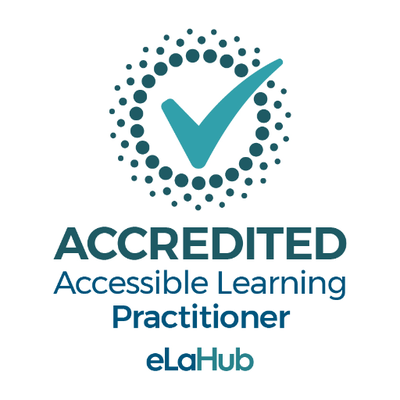Experienced and qualified
Accessibility is what we do.
Lyndal Box recently achieved the eLaHub Accredited Accessible Learning Practitioner credential. This is awarded to Learning and Development professionals who are committed to providing accessible learning content for everyone. Lyndal completed the Designing Accessible Learning Content Programme to formalise her expertise and picked up some new tips along the way.
Accessibility and inclusion
Just because it’s accessible doesn’t mean it’s inclusive.
Throughout the program the messages about user experience were clear. If designers only focus on meeting Web Content Accessibility Guidelines (WCAG) and ignore user experience testing, learning suffers. We are proud of our approach to learning design at LB Learning Solutions. It has always been about embedding inclusion and accessibility. It makes sense to us. Both accessibility and inclusion fit together. And we know that automated testing can only tell us so much. User experience testing gives us the bigger picture. All our designs are proudly user experience tested.
Use of authoring tools
The first step in accessible design is to stop designing for yourself, and consider other users.
The Accredited Accessible Learning Practitioner course was presented in Articulate Rise. For us that seemed an unusual choice of authoring tool. But it makes sense to demonstrate how learning design can be made accessible using the tools we have.
As it happens, most of our clients use Articulate Rise and Articulate Storyline authoring tools for their eLearning. Why wouldn’t they demonstrate accessibility using a common tool? When it comes to accessibility Articulate Storyline has more flexibility and is most often the preferred option between Rise and Storyline. So it was useful to see examples of responsible design within the least accessible tool.
Other authoring tools were referenced throughout the course too, and learners were encouraged to become more familiar with the tools they use the most. We all know there is no perfect tool. We also acknowledge that perfection doesn’t exist in design. But we make a commitment to continuing to progress our accessibility goals and standards with the tools and knowledge we have.
Designing for disability leads to innovation
1.3 billion disabled people worldwide is not a niche.
The most important takeaway from completing this program was the confirmation of how much accessible learning design matters. Some learning professionals provide excuses for not addressing accessibility. Common excuses include, “It takes too much time.”, “It costs too much”, and my all time favourite: “We don’t have disabled learners”. Our answer to that is “Yes, you do! But you just don’t know who they are.” Throughout the Accredited Accessible Learning Practitioner course there were no excuses. It was instead filled with benefits and greater motivation to reach higher standards. Great accessible learning design is efficient and cost effective. It also benefits everyone.
Over the years so many innovations that were created to break down barriers for people with disabilities have been adopted by others. And those innovations have become part of our every day. They include things like ramp access to buildings and voice activation tools in our homes. Accessible learning design benefits others in the same way. As we develop better ways to meet accessibility standards we recognise and adopt better design techniques to benefit a wider audience. You can observe that in LB Learning Solutions designs. It’s what we do.
Contact us to discuss how we can improve your current learning programs, and help you reach your learning goals in an accessible and inclusive way.
